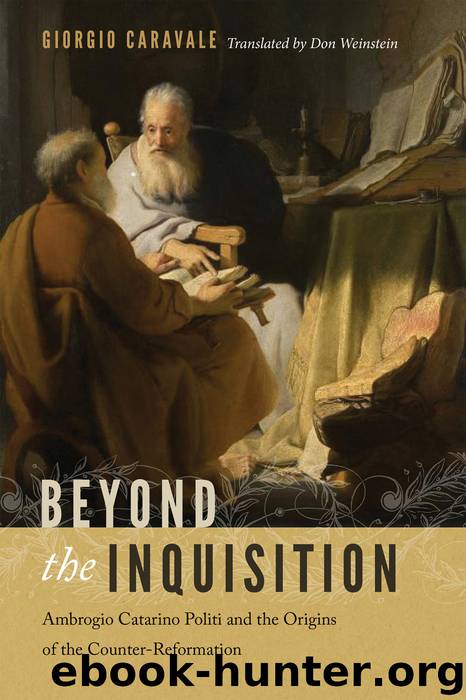Beyond the Inquisition by Caravale Giorgio; Weinstein Don;

Author:Caravale, Giorgio; Weinstein, Don;
Language: eng
Format: epub
Publisher: University of Notre Dame Press
Published: 2017-07-30T16:00:00+00:00
Chapter 2. Origins of the Polemic against Heresy
1. ASS, Conventi 3617, fols. 84v–85r. This was not the first time that Politi had come into contact with the monastery, as in 1529 he was referred to as “our spiritual father” (nostro padre spirituale); fol. 46v. Together with the archbishop of Siena, Francesco Bandini Piccolomini, and Lattanzio Tolomei, Politi raised the matter with Paul III so that the Benedictine monastery was brought back to observance, asking for the Jesuits to intervene directly for this purpose. The pope agreed and sent two of them, Pascasio Broët and Simon Rodriguez, to Siena on 19 March (see M. Del Piazzo and C. De Dalmases, “Il processo sull’ortodossia di s. Ignazio e dei suoi compagni svoltosi a Roma nel 1538,” Archivum Historicum Societatis Iesu 38 [1969]: 443 n. 13; on the Roman trial, see now also S. Pavone, “A Saint under Trial: Ignatius of Loyola between Alcalà and Rome,” in A Companion to Ignatius of Loyola. Life, Writings, Spirituality, Influence, ed. R. A. Maryks [Leiden: Brill, 2014], 45–64). More generally, on Politi’s relationship with the Jesuits, see G. Caravale, “Ambrogio Catarino Politi e i primi gesuiti,” and below.
2. Mostly because of the special legal position that Clement VII had granted him some years before—which released him from any tie of obedience to his superiors, placing him under the direct jurisdiction of the general of the order—he had cut any remaining ties with the Congregation of Siena; see above, ch. 1.
3. ASS, Conventi 3617, fols. 84v–85r. There is also evidence of the donation in G. Gigli, Diario Sanese, vol. II, p. 213; and in “Monumenta antiqua: De primo conventu fratrum minorum capuccinorum apud Senas,” Analecta Ordinis Fratrum Minorum Capuccinorum 19 (1903): 91–94.
4. ASS, Conventi 3617, fol. 85r.
5. Regarding Ripanti, see C. Cargnoni, “Fonti, tendenze e sviluppi della letteratura spirituale cappuccina primitiva,” Collectanea franciscana 48.3–4 (1978): 311–98, esp. 340–42; C. Cargnoni, “Introduzione,” in I Frati Cappuccini: Documenti e testimonianze del primo secolo, III/1, Letteratura spirituale ascetico-mistica (1535–1628), III/1, Letteratura spirituale ascetico-mistica (1535–1628), 46 et seq., ed. C. Cargnoni (Perugia: EFI, 1988–93), III/1, Letteratura spirituale ascetico-mistica (1535–1628), 46 et seq.; G. Caravale, Forbidden Prayer: Church Censorship and Devotional Literature in Renaissance Italy (Farnham: Ashgate, 2011), 110–11, 120–21, 124–25.
6. It was Girolamo da Molfetta, a brilliant speaker and follower of Ochino, who published a second edition of Cordoni’s Dialogo in Milan in 1539, adding the anonymous text Circolo del divino amore, recently attributed to Ripanti by Cargnoni (G. Caravale, Forbidden Prayer, 110).
7. On Giovanni da Fano, see Optatus a Veghel, “Jean de Fano,” in Dictionnaire de spiritualité, VII (Paris, 1974), 506–9, with corresponding bibliography. His clear antiheretical positions had been known since the publication of his Opera utilissima vulgare contra le pernitiosissime heresie lutherane per li simplici in Bologna in 1532; see also below.
8. V. Marchetti, Gruppi ereticali senesi del Cinquecento (Florence: La Nuova Italia, 1975), 18–19; M. Rosa, “Agostino da Treviso,” in DBI, vol. I (1960), 489–91; H. Jedin, “Ein Streit um den Augustinismus vor dem Tridentinum (1537–1543),” Römische Quartalschrift für christliche Altertumskunde und für Kirchengeschichte 35 (1927): 351–68.
Download
This site does not store any files on its server. We only index and link to content provided by other sites. Please contact the content providers to delete copyright contents if any and email us, we'll remove relevant links or contents immediately.
Fanny Burney by Claire Harman(26249)
Empire of the Sikhs by Patwant Singh(22774)
Out of India by Michael Foss(16695)
Leonardo da Vinci by Walter Isaacson(12810)
Small Great Things by Jodi Picoult(6691)
The Six Wives Of Henry VIII (WOMEN IN HISTORY) by Fraser Antonia(5241)
The Wind in My Hair by Masih Alinejad(4850)
The Crown by Robert Lacey(4578)
The Lonely City by Olivia Laing(4572)
A Higher Loyalty: Truth, Lies, and Leadership by James Comey(4558)
The Iron Duke by The Iron Duke(4126)
Millionaire: The Philanderer, Gambler, and Duelist Who Invented Modern Finance by Janet Gleeson(4108)
Sticky Fingers by Joe Hagan(3916)
Papillon (English) by Henri Charrière(3914)
Joan of Arc by Mary Gordon(3790)
Alive: The Story of the Andes Survivors by Piers Paul Read(3737)
Stalin by Stephen Kotkin(3730)
Aleister Crowley: The Biography by Tobias Churton(3429)
Ants Among Elephants by Sujatha Gidla(3282)
